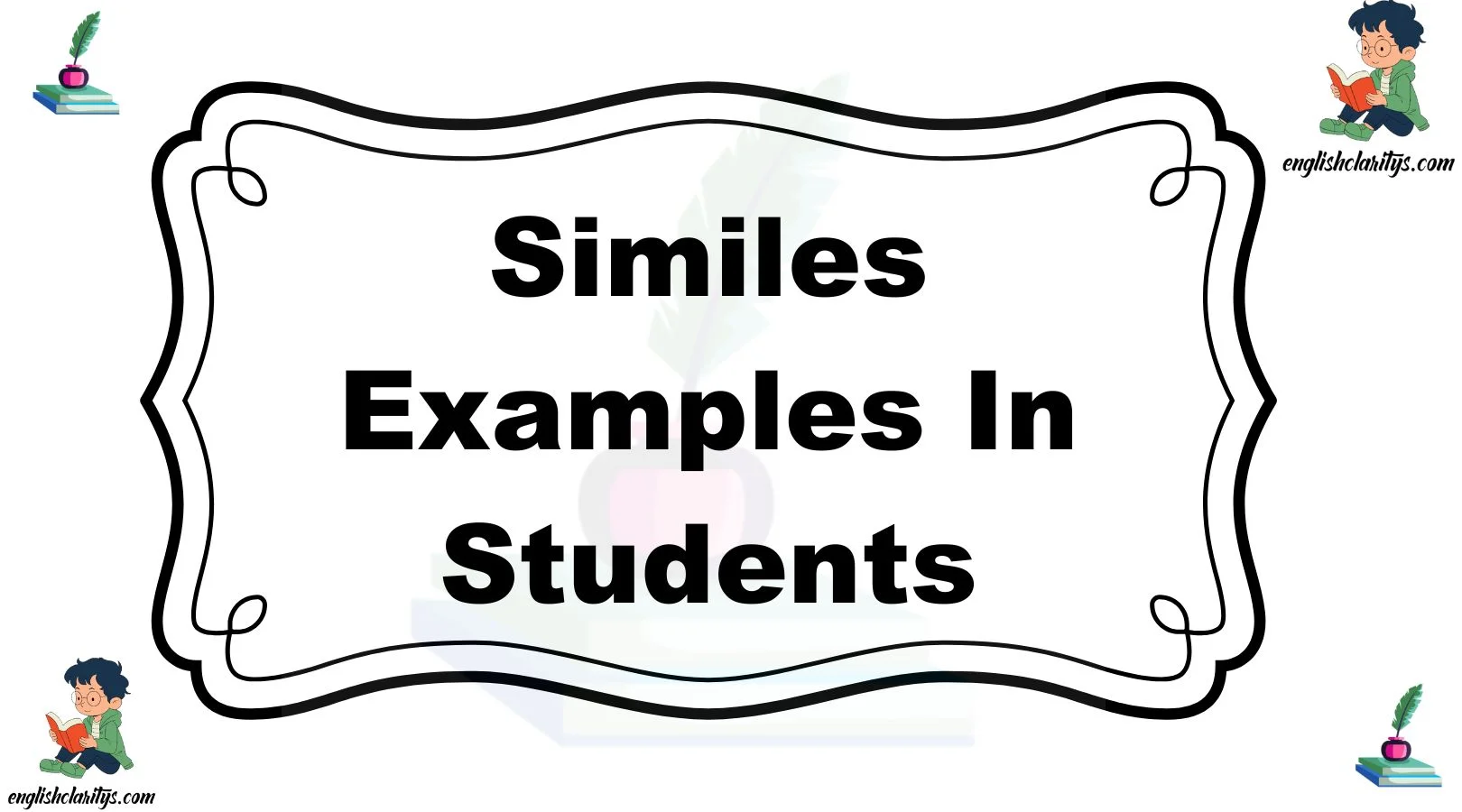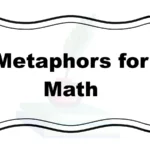Expressing feelings, thoughts, and observations in a warm and thoughtful way is an important skill—especially when communicating with students. Using the right words can turn an ordinary sentence into something memorable and heartfelt. Similes are a powerful tool to make language vivid, relatable, and meaningful.
They create strong mental images by comparing one thing to another using “like” or “as.” For students, similes can bring learning to life and make descriptions more engaging. Whether you’re a teacher encouraging a student or a student describing your own experience, these 30 simile examples will inspire you to express yourself with care and creativity.
1. As bright as a sunflower
Meaning: Someone who is cheerful and full of positive energy.
Explanation: This simile compares a student’s mood or personality to a sunflower’s bright and sunny appearance. It suggests happiness and warmth.
Example: Maria is as bright as a sunflower, always lighting up the classroom with her smile.
Other ways to say:
- As radiant as the morning sun
- Like a beam of sunshine
- As cheerful as a spring day
2. Like a sponge
Meaning: Someone who absorbs knowledge quickly.
Explanation: Just as a sponge soaks up water, this simile describes a student eager and quick to learn new things.
Example: Jason is like a sponge when it comes to math—he picks up concepts fast.
Other ways to say:
- As absorbent as a dry towel
- Like a vacuum for information
- As quick as a flash in learning
3. As busy as a bee
Meaning: A student who is hardworking and constantly active.
Explanation: Bees are known for their constant work. This simile highlights diligence and busyness in a positive way.
Example: Lily has been as busy as a bee preparing for her exams.
Other ways to say:
- Like a hardworking ant
- As diligent as a worker bee
- Busy as a buzzing hive
4. Like a bookworm
Meaning: Someone who loves reading and spends a lot of time with books.
Explanation: This compares a student’s love for books to a “bookworm,” a creature that metaphorically “devours” books.
Example: Sam is like a bookworm; he reads every chance he gets.
Other ways to say:
- As studious as an owl
- Like a scholar in the library
- As engrossed as a detective
5. As sharp as a tack
Meaning: A student who is very intelligent and quick to understand.
Explanation: A tack is small but very sharp, symbolizing keen intellect or alertness.
Example: Emma is as sharp as a tack and solves problems effortlessly.
Other ways to say:
- Like a bright spark
- As clever as a fox
- Quick as lightning
6. Like a butterfly
Meaning: Someone who is lively and graceful but may change quickly.
Explanation: Butterflies move gently and gracefully but flutter from place to place, sometimes implying restlessness or curiosity.
Example: Alex is like a butterfly, always exploring new clubs and activities.
Other ways to say:
- As free as the wind
- Like a hummingbird in motion
- Graceful as a dancer
7. As steady as a rock
Meaning: A student who is dependable and calm under pressure.
Explanation: Rocks are strong and unmoving, symbolizing reliability and steadiness.
Example: During exams, Mia was as steady as a rock, keeping calm throughout.
Other ways to say:
- Like a calm ocean
- As firm as a mountain
- Steadfast as an oak tree
8. Like a lightning bolt
Meaning: Someone who acts or thinks very quickly.
Explanation: Lightning strikes swiftly and powerfully, symbolizing rapid action or thought.
Example: Tom answered the questions like a lightning bolt during the quiz.
Other ways to say:
- As fast as a cheetah
- Like a flash of light
- Quick as a snap
9. As quiet as a mouse
Meaning: A student who is very quiet and unobtrusive.
Explanation: Mice are small and silent creatures, making this simile perfect for describing shyness or calmness.
Example: In class, Sara is as quiet as a mouse, listening carefully without interrupting.
Other ways to say:
- Like a whisper
- As silent as snow
- Quiet as the night
10. Like a shining star
Meaning: A student who stands out because of their achievements or personality.
Explanation: Stars shine brightly and are easy to notice, symbolizing excellence or uniqueness.
Example: Kevin is like a shining star in our class for his hard work and kindness.
Other ways to say:
- As bright as a diamond
- Like a beacon of light
- Radiant as the sun
11. As strong as a lion
Meaning: Someone who shows courage and strength.
Explanation: Lions represent bravery and power, so this simile highlights inner strength.
Example: During the debate, Anna was as strong as a lion, standing firm on her points.
Other ways to say:
- Like a fearless warrior
- As brave as a knight
- Strong as an ox
12. Like a chameleon
Meaning: Someone who adapts easily to different situations.
Explanation: Chameleons change their colors to blend in, symbolizing flexibility and adaptability.
Example: John is like a chameleon, fitting in wherever he goes.
Other ways to say:
- As adaptable as water
- Like a shape-shifter
- Flexible as a gymnast
13. As light as a feather
Meaning: Feeling carefree or having a light mood.
Explanation: Feathers are extremely light, symbolizing ease and lack of burden.
Example: After finishing his exams, Mark felt as light as a feather.
Other ways to say:
- Like a floating cloud
- As free as a bird
- Light as air
14. Like a candle in the dark
Meaning: Someone who brings hope or guidance.
Explanation: A candle provides light and comfort in darkness, symbolizing inspiration or help.
Example: Ms. Parker is like a candle in the dark for struggling students.
Other ways to say:
- As comforting as a warm fire
- Like a lighthouse beam
- Guiding as a northern star
15. As busy as a squirrel
Meaning: A student who is constantly active and preparing for the future.
Explanation: Squirrels are always gathering food, showing preparedness and energy.
Example: Ella has been as busy as a squirrel preparing for college applications.
Other ways to say:
- Like a busy bee
- As active as a hummingbird
- Always on the move
16. Like a ticking clock
Meaning: Someone who is always on schedule or punctual.
Explanation: A clock represents precision and consistency, often used to describe students who value time and deadlines.
Example: Zara is like a ticking clock—always arriving on time and never missing homework.
Other ways to say:
- As punctual as sunrise
- Like a timekeeper
- As reliable as a Swiss watch
17. As curious as a cat
Meaning: A student who is very inquisitive and loves asking questions.
Explanation: Cats are naturally curious creatures, often exploring new things, making this perfect for intellectually curious students.
Example: Noah is as curious as a cat, always wanting to learn more about the world.
Other ways to say:
- Like a little explorer
- As questioning as a philosopher
- Inquisitive like a scientist
18. Like a blank canvas
Meaning: Someone full of potential, open to learning and growing.
Explanation: A blank canvas can become anything, symbolizing limitless potential and new beginnings.
Example: Every new student is like a blank canvas, ready to be filled with experiences and knowledge.
Other ways to say:
- As open as a notebook
- Like an empty page waiting to be written
- Full of possibilities
19. As playful as a puppy
Meaning: Describes someone joyful, energetic, and playful.
Explanation: Puppies are known for their lively and affectionate nature, making this a fun simile for cheerful students.
Example: Ella is as playful as a puppy, spreading laughter wherever she goes.
Other ways to say:
- Like a bundle of joy
- As bouncy as a ball
- Cheerful as a summer breeze
20. Like a lighthouse
Meaning: Someone who offers guidance and reassurance to others.
Explanation: A lighthouse stands strong to help others find their way, symbolizing leadership and care.
Example: Mr. Hale is like a lighthouse for his students, always offering wisdom and direction.
Other ways to say:
- As guiding as a teacher’s hand
- Like a northern star
- Steady as a mentor
21. As clever as a fox
Meaning: A student who is smart and strategic.
Explanation: Foxes are often seen as intelligent and quick-witted, making this a flattering comparison.
Example: David was as clever as a fox during the debate, making sharp points with confidence.
Other ways to say:
- Like a brainy strategist
- Sharp as a tack
- As wise as an owl
22. Like a ticking bomb
Meaning: Someone who might suddenly react or is filled with intense pressure.
Explanation: A ticking bomb builds tension and can metaphorically represent stress or suppressed emotion.
Example: Under the pressure of exams, Leo felt like a ticking bomb.
Other ways to say:
- As tense as a drum
- Like a shaken soda can
- About to burst
23. As peaceful as a lake
Meaning: A student who is calm and composed.
Explanation: Still lakes represent inner calm and tranquility, ideal for describing serene personalities.
Example: Nina is as peaceful as a lake, even during school presentations.
Other ways to say:
- Like a calm breeze
- As composed as a monk
- Tranquil like morning fog
24. Like a rocket
Meaning: Describes someone who makes rapid progress or has big ambitions.
Explanation: Rockets move fast and aim high—perfect for driven students with lofty goals.
Example: Since joining the science club, Sophia has taken off like a rocket.
Other ways to say:
- As ambitious as a dreamer
- Like a rising star
- Speeding toward success
25. As proud as a peacock
Meaning: A student who takes great pride in their accomplishments.
Explanation: Peacocks strut confidently, symbolizing pride and self-assurance.
Example: When he won the art contest, Ethan was as proud as a peacock.
Other ways to say:
- Like someone walking on clouds
- As confident as a performer
- Proud as a champion
26. Like a ticking metronome
Meaning: Someone who maintains a steady pace in their studies.
Explanation: A metronome keeps time rhythmically, much like a student who manages routine well.
Example: Jacob is like a ticking metronome—always consistent in his homework habits.
Other ways to say:
- As rhythmic as a drumbeat
- Like clockwork
- Steady as a pendulum
27. As loud as thunder
Meaning: A student with a bold personality or voice.
Explanation: Thunder represents powerful presence or volume.
Example: James is as loud as thunder during recess—everyone hears him laugh.
Other ways to say:
- Like a booming speaker
- As bold as a lion’s roar
- Echoes in the room
28. Like a detective
Meaning: Someone who investigates thoroughly or thinks critically.
Explanation: Detectives are observant and analytical—great for describing students who think deeply.
Example: Emma is like a detective during group projects, always solving the hardest parts.
Other ways to say:
- As curious as a sleuth
- Like a riddle solver
- Analytical as a scientist
29. As stubborn as a mule
Meaning: A student who is very persistent or unwilling to change.
Explanation: Mules are known for sticking to their ground, used here to show strong determination (sometimes inflexibility).
Example: Alex is as stubborn as a mule when it comes to his opinions.
Other ways to say:
- Like a rock that won’t budge
- Unmovable as a statue
- As firm as concrete
30. Like a whirlwind
Meaning: Someone who is energetic, fast-moving, and maybe a little chaotic.
Explanation: A whirlwind rushes through quickly, symbolizing high energy and action.
Example: When Ava enters a room, she’s like a whirlwind—full of ideas and excitement.
Other ways to say:
- As lively as a storm
- Like a burst of energy
- Fast as a tornado
Conclusion:
Using similes in writing and speaking gives language a rich, emotional tone that’s both engaging and expressive. For students, similes are not just figures of speech—they are creative tools to describe feelings, actions, and personalities with warmth and clarity. From “as bright as a sunflower” to “like a whirlwind,” each simile in this article paints a vivid picture that helps connect thoughts with imagination.
Whether you’re a student, parent, or teacher, using these phrases can make communication more personal, meaningful, and memorable. Let these similes become part of your vocabulary and watch your expression become more thoughtful and inspiring.
Multiple Choice Questions:
1. What does “as proud as a peacock” imply?
a) The student is shy
b) The student is graceful
c) The student takes pride in achievements
d) The student is very quiet
Answer: c) The student takes pride in achievements
2. A student who is “like a sponge” is:
a) Disorganized
b) Easily distracted
c) Quick to absorb knowledge
d) Always noisy
Answer: c) Quick to absorb knowledge
3. “As quiet as a mouse” best describes:
a) A student who is good at sports
b) A loud student
c) A very shy or silent student
d) A confident speaker
Answer: c) A very shy or silent student
4. “Like a butterfly” suggests someone who:
a) Is steady and focused
b) Is energetic and playful
c) Moves gracefully or explores new things
d) Refuses to change
Answer: c) Moves gracefully or explores new things
5. “As strong as a lion” means:
a) The student has physical strength
b) The student is loud
c) The student is brave and confident
d) The student is lazy
Answer: c) The student is brave and confident
6. What quality is shown by “like a ticking clock”?
a) Laziness
b) Punctuality
c) Nervousness
d) Strength
Answer: b) Punctuality
7. Which simile shows someone who adapts easily?
a) As stubborn as a mule
b) Like a chameleon
c) Like a ticking metronome
d) As loud as thunder
Answer: b) Like a chameleon
8. If someone is “like a detective,” they are:
a) Very fast
b) Very loud
c) Very curious and observant
d) Always sleeping
Answer: c) Very curious and observant
9. “As peaceful as a lake” describes a student who is:
a) Stressed
b) Energetic
c) Calm and composed
d) Extremely stubborn
Answer: c) Calm and composed
10. “Like a whirlwind” refers to:
a) Someone lazy
b) Someone very organized
c) Someone who brings chaos and energy
d) Someone shy and reserved
Answer: c) Someone who brings chaos and energy
11. Who is likely to be “as clever as a fox”?
a) A slow learner
b) A student who asks too many questions
c) A smart and strategic thinker
d) A quiet and shy child
Answer: c) A smart and strategic thinker
12. “As playful as a puppy” means:
a) The student is always asleep
b) The student is energetic and joyful
c) The student is very serious
d) The student is calm
Answer: b) The student is energetic and joyful
13. Which simile shows someone who learns at a steady pace?
a) Like a whirlwind
b) Like a ticking metronome
c) As loud as thunder
d) As curious as a cat
Answer: b) Like a ticking metronome
14. What is meant by “like a blank canvas”?
a) A student with no creativity
b) A student with nothing to offer
c) A student full of potential and ready to learn
d) A student who doesn’t talk
Answer: c) A student full of potential and ready to learn
15. “As stubborn as a mule” suggests:
a) The student is very adaptable
b) The student gives up easily
c) The student never finishes anything
d) The student is persistent or unwilling to change
Answer: d) The student is persistent or unwilling to change
FAQs:
1. What is a simile, and why is it important for students?
A simile is a figure of speech that compares two different things using the words “like” or “as” to create vivid imagery or emotional effect. For students, similes help improve writing clarity, creativity, and emotional expression, making language more relatable and easier to understand.
2. How can similes help in student communication and learning?
Similes allow students to connect complex ideas to familiar concepts, making communication more engaging and memorable. They also help build storytelling, descriptive writing, and presentation skills—vital tools in academic and everyday life.
3. Are similes different from metaphors?
Yes, similes and metaphors are similar but different. A simile uses “like” or “as” (e.g., as fast as lightning), while a metaphor makes a direct comparison without those words (e.g., He is a shining star). Both enhance writing, but similes are often easier for young learners to grasp.
4. Can students use similes in formal writing or essays?
Absolutely! Similes can be effective in formal writing—when used appropriately. They can clarify a concept, create impact, or add color to an argument. However, students should use them sparingly and thoughtfully to maintain academic tone and clarity.
5. How can teachers encourage students to use similes more confidently?
Teachers can promote simple use by incorporating creative writing exercises, group brainstorming, and daily prompts. Offering positive feedback and showcasing great examples from peers can help students feel more confident using similes in their own writing.




